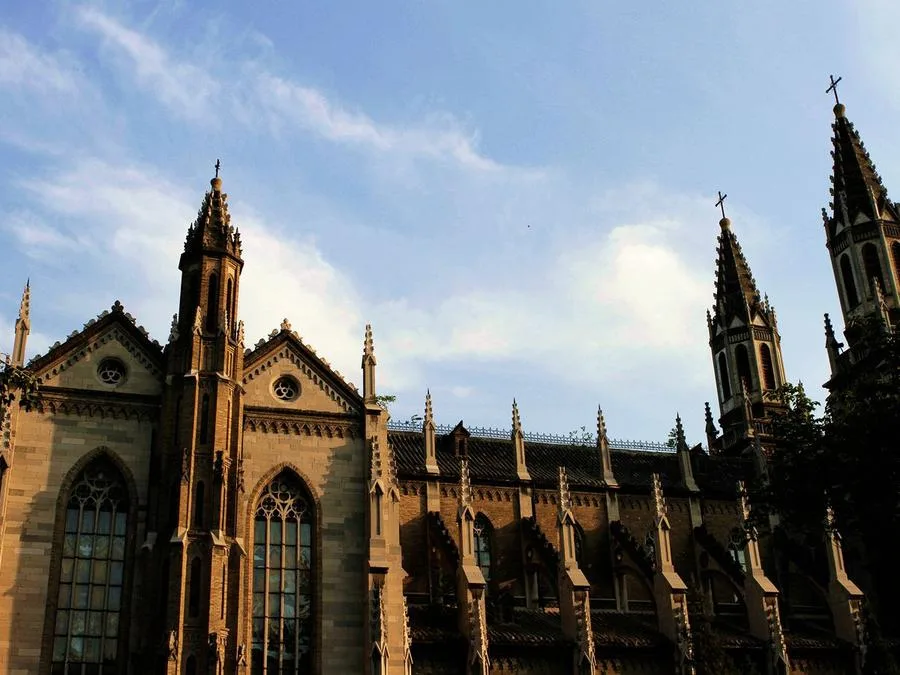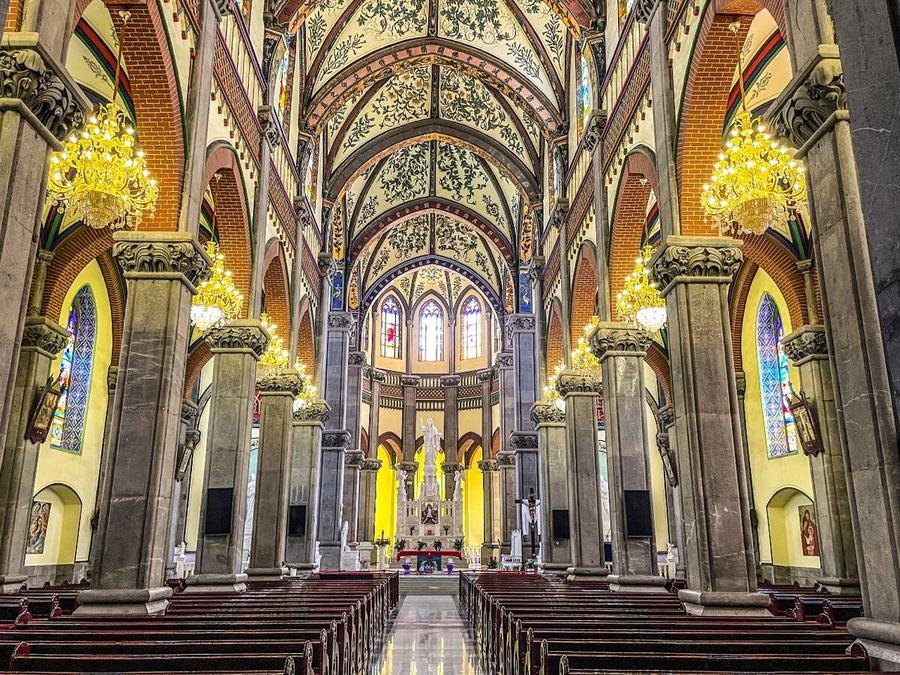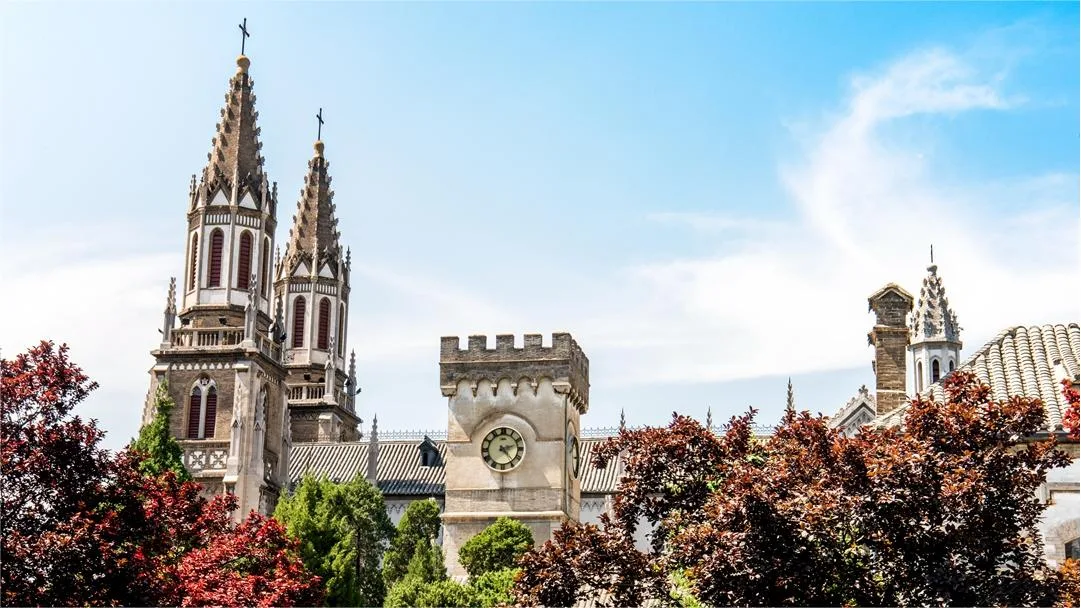The Hongjialou Sacred Heart Cathedral (洪家楼圣心教堂), commonly known as Hongjialou Cathedral (洪家楼天主堂), is named after its location in Hongjialou Village, Jinan. It was constructed using the Boxer Indemnity funds from the 1900 Boxer Protocol, designed by Austrian missionary Brother Paul and built by Chinese laborers. Construction began in 1901 and took over three years to complete, finishing in May 1905. The cathedral faces west and is designed in the typical Gothic architectural style, with a cross-shaped floor plan symbolizing the crucifixion of Jesus Christ.
With a building area of about 2,600 square meters, the cathedral can accommodate over a thousand people for religious activities. It is the largest Catholic church in Jinan and northern China and one of the three most famous Catholic churches in China. The Hongjialou Sacred Heart Cathedral holds significant importance in the context of modern Chinese religious architecture.
Table of Contents
- Basic Information
- Location and Transportation
- Highlights of Hongjialou Cathedral
- Vlog about Hongjialou Cathedral
- History of Hongjialou Cathedral
- Other Attractions in Jinan Urban Area
Basic Information
| Estimated Length of Tour | 1 hour |
| Ticket Price | Free |
| Opening Hours | 9.00 – 16.00 (Monday – Saturday) 8.00 – 19.00 (Sunday) |
Location and Transportation
Hongjialou Cathedral is located in the eastern part of Jinan, Shandong Province, at No. 3 Hongjialou, Huayuan Road, Licheng District. It is adjacent to the Hongjialou campus of Shandong University. To get there, you can take bus 311, 318, 573, B165, B98, BRT 5, K10, K1, or T7, and get off at Hongjialou Stop (洪家楼站).
Highlights of Hongjialou Cathedral
Exterior Architecture

Hongjialou Sacred Heart Cathedral is a striking example of twin-tower Gothic architecture. Expanded in 1906 during the 32nd year of the Guangxu Emperor’s reign, its design reflects the Gothic styles prevalent in Europe from the 12th to early 16th centuries, bearing similarities to renowned cathedrals like Canterbury Cathedral, Notre-Dame de Paris, Chartres Cathedral, and Westminster Abbey.
The cathedral is oriented east to west, featuring a narrow front and a wider rear with multiple angles, facets, doors, and windows. The building spans approximately 2600 square meters, with the sanctuary located at the eastern end. The façade is dominated by two prominent spire towers, each about 60 meters tall, flanking the main entrance. These towers are characterized by their pointed arches and intricate floral carvings above the doors. At the rear, two additional spires, approximately 55 meters high, mirror the front towers, creating a balanced, symmetrical design. The entire structure is constructed of blue bricks and quarried stones.

The central aisle of the cathedral is elevated and spacious, supported by two rows of longitudinal columns. The floor is paved with blue flagstones, while the ceiling and walls are adorned with detailed murals and decorations.
Adjacent to the cathedral on the south side is a two-story cloister complex centered around a clock tower. This square, spire-topped tower stands four stories high and is flanked by two-story Western-style cloister buildings on the east and west sides. This section adds to the cathedral’s grandeur and provides additional space for various activities and gatherings.
Despite its predominantly Western architectural style, the cathedral incorporates elements of traditional Chinese culture. The roof of the main hall is covered with small black tiles typical of Chinese architecture. Additionally, the stone walls flanking the central door feature intricately carved dragon heads, their mouths agape and eyes wide in a fierce expression, adding a touch of Chinese artistry. Inside, murals of cranes can be seen, blending local cultural motifs with the Gothic structure.
Interior Design

The interior of Hongjialou Cathedral is equally impressive. The central nave is lofty and extends deep into the building, providing a grand sense of space. The floor is laid with blue flagstones, and the hall is lined with around 40 square columns. These columns are intricately carved with hollow floral patterns at their capitals. The vaulted ceilings and walls are embellished with vivid murals, predominantly featuring floral motifs, which contribute to the cathedral’s rich religious ambiance.
Natural light floods the interior through the stained glass windows, which cast vibrant, colorful patterns on the walls and floors. This interplay of light and color enhances the spiritual atmosphere of the space, creating a serene and contemplative environment for worshippers.
Vlog about Hongjialou Cathedral
History of Hongjialou Cathedral
The Hongjialou Sacred Heart Cathedral began construction in 1901 during the 27th year of Emperor Guangxu’s reign in the Qing Dynasty. The design and supervision were overseen by Brother Corbinius Panger, an Austrian Franciscan friar. In 1904, German construction expert Lü Licheng was specially appointed to be the chief contractor and supervisor of the project. He brought over a hundred stonemasons from his village and managed more than a thousand workers on the site. The construction, which adhered to the provided blueprints and involved meticulous coordination of stone carving, carpentry, and tile work, took three years to complete and was finished in 1905.
In 1937, during the 26th year of the Republic of China, the Japanese invasion of China led to the occupation of Jinan. The church district suffered damage, and church members faced persecution. By September 1948, during the liberation of Jinan by the People’s Liberation Army, the area around Hongjialou was also affected. Although the seminary had relocated, the cathedral complex sustained some damage from bombings, but the main church structure remained largely intact.
The Cultural Revolution (1966-1976) had a profound impact on religious institutions across China. In 1966, the Hongjialou Cathedral was closed, and all religious activities were suspended until 1983. In 1985, the Jinan city government allocated special funds to restore the cathedral. This extensive renovation included repairs to six crosses, 96 stone flower carvings, and restoration of murals, statues, floors, kneelers, altars, and lighting fixtures. On December 25, 1985, Christmas Day, the cathedral reopened after nearly two decades of closure and hosted a grand mass to celebrate the occasion.







